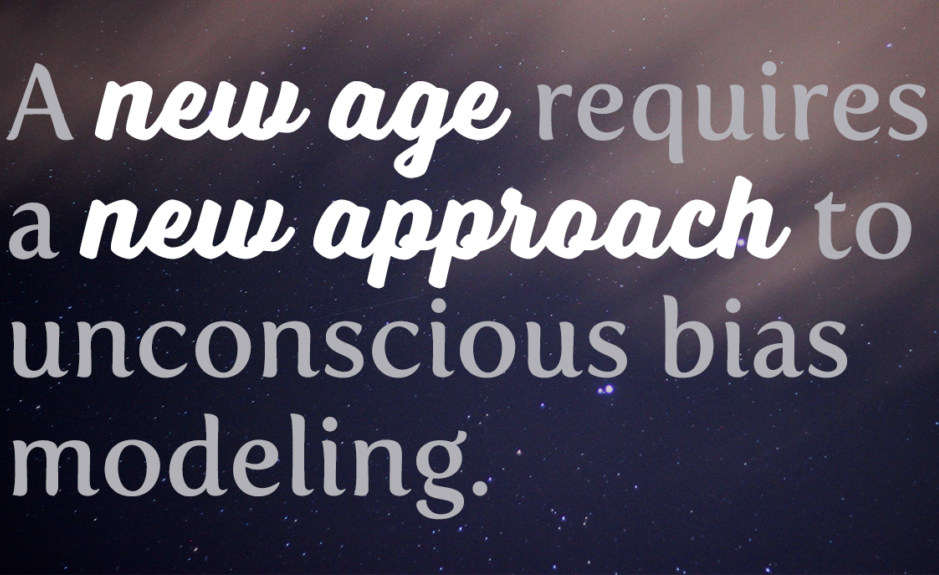Unconscious Futures Modeling

In recent years, huge companies such as Google and Facebook have adopted the practice of “Unconscious Bias Modeling,” taking their employees through workshops to uncover hidden biases and assumptions that are impacting innovation, diversity, creativity and decision making.
Though these initiatives and efforts are admirable, their attempt to uncover unconscious biases suffer from the same fatal flaw as most of today’s organizational, governmental or social programs that are designed to overcome complex problems and develop manageable solutions: They start from a place of closed feedback loops, traditional mindsets and known categories in a world that has become increasingly volatile and ambiguous.
In other words, they are attempting to learn a brand new game while using all of the same old rules.
Trying to solve any complex problem from the landscape of that problem’s original matrix is akin to drinking poison in order to kill an infection. In the same way, the path to transformative thinking is not achieved via traditional unconscious bias identification.
A Nod to “Fake News”
Humans have always been pretty good at formulating, believing, and disseminating fake news. Continuing to seek out credible sources is important, and this keeps us all on our toes. The real problem today is the availability and speed, via online sources and social media tribes, networks, and extended communication. It isn’t even just the information – the zeitgeist created by the information can be even more impactful.
As good futurists, we need to track the rise of “fake news,” and this means being aware of what is being disseminated, and the impact that the message is having. Will it cause an anti-technology backlash? Will it escalate a move toward a circular economy? Will it result in a greater divide between the haves and have-nots of the present economic system? Increased global conflict? Digital city-states, mayors as world leaders, or virtual citizenship?
We need to understand why the myths and metaphors rise, fall, persist, or shift. Curating a broad and deep scanning repository helps us to keep our finger on the global pulse, as many reliable sources also inform us of differing views on the scene.
Ultimately, much of “fake news” comes from a desire to reclaim agency in the face of change that we may have been left out of, a desire to restore a past (romanticized or not) that we identify with (having been left out of growing into a new identity), and a desire to strike back at those who take us to a place that we fear because we don’t understand (because we were left out economically or technologically or socially). We must intentionally work on bringing all of humanity along into the future.
Since the way that we think about and engage with the future informs our present actions, we really need what we call Unconscious Futures Modeling as a way to move past the closed feedback loops of developmental thinking.
When we go beyond the present to reveal our assumptions about the future (as well as the past), we can transition to a state of “emergence” or transformation that transcends traditional boundaries. It is this way of thinking that allows us to really see how things can be different, how WE can be different and how we can create pathways of positive change.
This different way of thinking – which is also known as Ontological Unpredictability – allows us to embrace complexity in order to identify new mental and physical categories outside of our realm or perspective of “knowing” – a type of “dark matter exploration” or discovery of the “unknown unknowns.”
Since we cannot predict the future, especially in environments of exponentially accelerating complexity, our leaders and organizations need to learn quantum thinking – thinking outside of our classical framework – in order to identify new categories of existence and possibility. A “wicked problems” framework approaches our world from a developmental approach, which is to say linearly or incrementally, and from the landlocked perspective of present problems and solutions.
Our “Wicked Opportunities®” framework approaches “world building” transformatively, leveraging accelerating complexity for new category creation, intentional evolutionary leapfrogging and breakpoint discovery that highlights higher-order purpose migration over old order incremental iteration.
So then, would you rather tackle biases and assumptions with the same mindsets that created them, or do you want to shift your organization’s perspective to a place of alternatives, possibilities and simultaneous multiple perspectives?
You can read more about Wicked Opportunities framework here, and watch an infographic here. Reach out to us and we’d love to tell you more!

